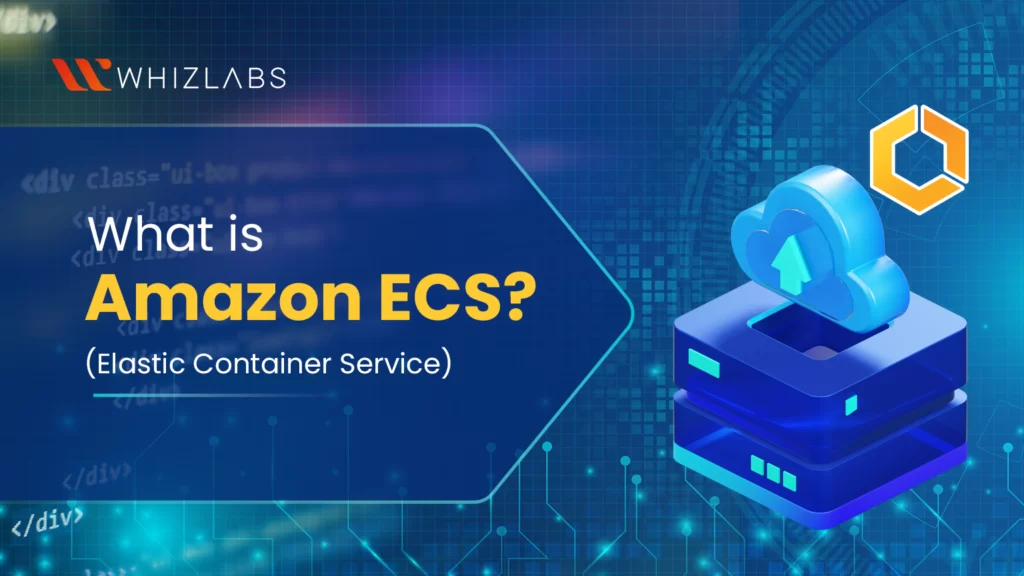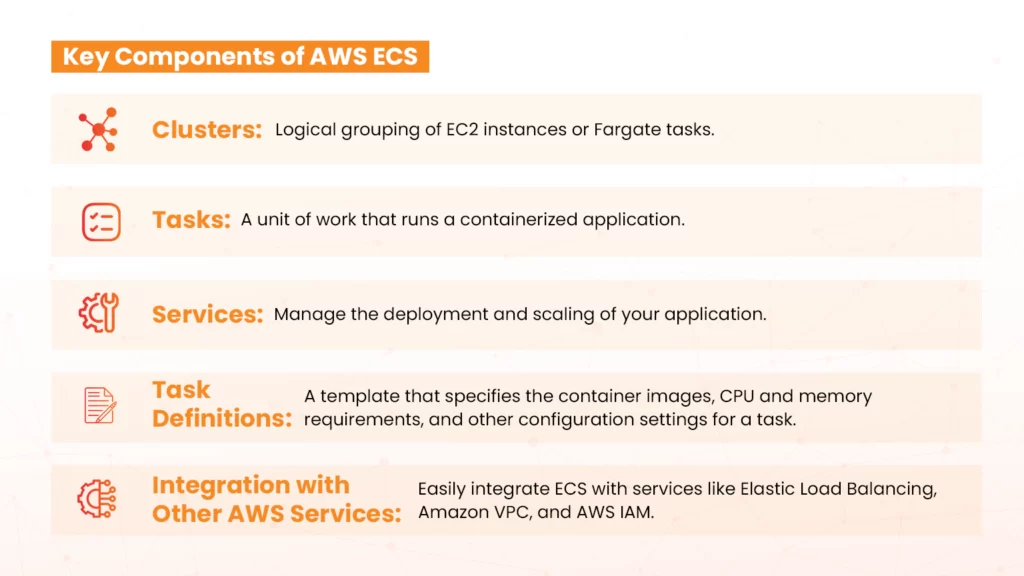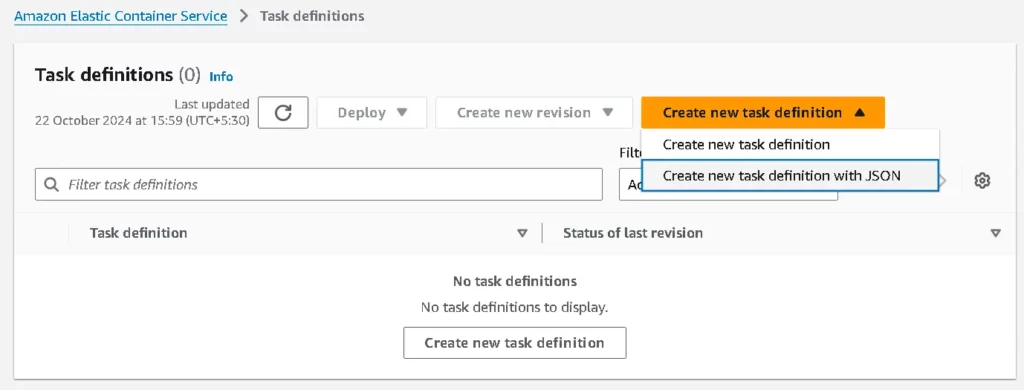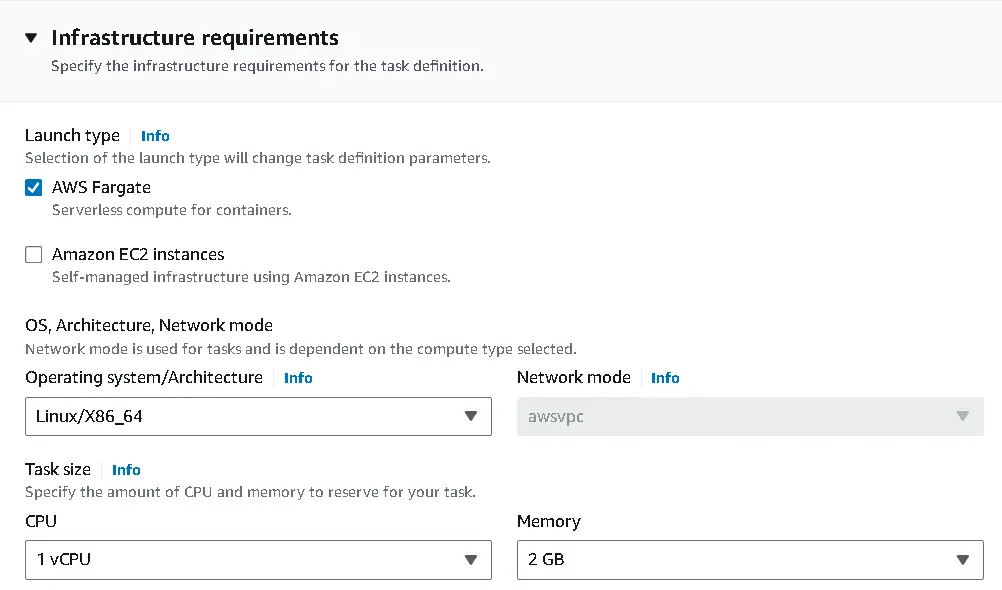This blog helps you understand Amazon ECS in the context of cloud computing and explains how it can simplify container management for developers and businesses. Read through to get an overview of best practices for deploying ECS and efficient strategies for using Amazon ECS.
Overview of Amazon Elastic Container Service (ECS)
Amazon ECS is a highly scalable and managed container orchestration service provided by Amazon Web Services. It provides an easy-to-use method for cloud deployment and management of containerized applications. With ECS, developers can focus on creating and implementing applications instead of dealing with infrastructure management.
One of its most notable features is its deep integration with the AWS ecosystem, which enables smooth connections with other services like Amazon RDS, Amazon S3, and AWS IAM for security management. Additionally, it includes powerful scheduling options, enabling users to define how and when tasks should run.
Amazon ECS: Simplifying Container Management in the Cloud
ECS is a very scalable and performant container management service that makes it simple to start, stop, and manage Docker containers on a cluster of Amazon EC2 instances. It offers two deployment models.
1. Create a cluster: Select Fargate or EC2 instances for your cluster. While Fargate gives a serverless experience, EC2 gives you more control over the underlying infrastructure.
A) EC2-Launch Type: This gives you granular control over your EC2 instances, which is ideal for specific hardware requirements or custom configurations.
Step 1: Choose EC2 instances.
Step 2: Create a task definition specifying container images, CPU and memory requirements, and environment variables.
Step 3: Launch a service based on the task definition.
Pros: More control over the underlying infrastructure, allowing for customization and optimization.
Cons: Requires more management overhead, including patching and maintenance.
B) AWS Fargate: Serverless services eliminate the need to manage EC2 instances, making it ideal for simpler applications.
Step 1: Specify CPU and memory requirements for your task.
Step 2: Create a task definition.
Step 3: Launch a service.
Pros: Serverless experience eliminates the need to manage infrastructure.
Cons: You have less control over the underlying resources.
Take your application’s CPU, memory, and storage needs into account before selecting an instance type. Control network access with subnets and security groups to set up networking, activate cloudwatch logging, and monitor the functionality and health of your cluster. Use tags to organize your resources using tags.
2. Define Tasks: Create task definitions that specify the container images, CPU and memory requirements, and other configuration settings for your tasks.
- Step 1:Firstly, create a task definition using the AWS CLI or the ECS console.
- Step 2: Add the container images that your task will use.
- Step 3: Set CPU and memory limits and allocate the necessary resources for your task.
- Step 4: Specify the network mode and any necessary port mappings.
- Step 5: Provide environment variables that your task needs.
3. Create Services: Deploy your tasks as services that can automatically scale up or down based on demand.
- Use the ECS console or the AWS CLI to create a service.
- Select the task definition that you created.
- Specify the number of tasks that you want to run.
- If necessary, configure load balancing for your service.
- Set scaling policies: Define rules for automatically scaling your service up or down.
4. Load Balance Traffic: Use Elastic Load Balancing to distribute traffic across your services.
- Use the load balancer to register your ECS service.
- Define listeners that will route traffic to your service.
5. Manage and Monitor: Use the ECS console or the AWS CLI to monitor the health of your clusters, services, and tasks.
- Keep track of the health of your clusters, services, and tasks.
- Use the AWS CLI to automate tasks and integrate with other AWS services.
- Log your cluster’s events and metrics for analysis and enable CloudWatch logs.
- Create alarms to notify you of any issues.
6. Accessing Your Application
- Find the DNS name of your load balancer.
- Access your application: Use a web browser or other client to access your application using the load balancer DNS name.
Ideal Practices to Make Your Amazon ECS Deployment Work Better
It is crucial to adhere to deployment best practices if you want to get the most out of Amazon ECS. This entails choosing the appropriate launch type depending on the needs of your application and efficiently using task definitions to specify the resources required for your containers.
Another best practice is to use ECS service auto-scaling, which adjusts the number of running tasks based on demand, maximizing resource utilization. Furthermore, employing appropriate AWS CloudWatch logging and monitoring can yield insights that support troubleshooting and enhance application performance.
- Create reusable task definitions to simplify deployment and management and Use task definitions effectively.
- To maximize cluster configuration, select the appropriate instance types and cluster size according to the requirements of your application.
- Use ECS Fargate for a serverless experience; it eliminates the need for infrastructure management.
- For increased scalability and dependability, use common ECS patterns such as blue-green deployments, canary deployments, and service discovery.
Amazon ECS: Integration With Other AWS Services for Seamless Operations
The seamless integration of Amazon ECS with other AWS services is one of its biggest benefits. For instance, users can track the health and performance of containers by using AWS CloudWatch for logging and monitoring.
Furthermore, for CI/CD workflows, ECS integrates seamlessly with AWS CodePipeline and AWS CodeDeploy, simplifying the deployment process automation. By utilizing AWS IAM for role-based access control, this integration not only improves security and compliance but also streamlines operations.
Why Should You Manage Your Containers in Amazon ECS?
- When you are familiar with managing containers on Amazon ECS, it becomes an easy-to-use service with reduced infrastructure management overhead and seamless scaling—built-in redundancy and fault tolerance ensure that your applications remain available even in the event of failures.
- Amazon ECS provides an affordable and efficient solution for running containerized applications. Incorporating a pay-as-you-go pricing model allows you to optimize your costs based on your application’s needs.
- You can automatically scale your applications based on demand by implementing on-demand EC2 instances, which guarantees optimal resource utilization.
- Monitoring and managing your containerized environment is made easier with ECS’s integration with other AWS services like CloudWatch, ECR, and IAM.
- You can concentrate on developing and implementing your apps instead of maintaining a complicated container orchestration infrastructure.
Amazon ECS Use cases
Microservices: By offering native integration to AWS and facilitating continuous integration and continuous deployment (CI/CD) pipelines, Amazon ECS helps microservices applications run.
Cloud app migration: It is feasible to containerize and move legacy enterprise apps to Amazon ECS without requiring any code modifications. This is an example of the migration of lift-and-shift applications. ECS also works with batch processing.
VMs: The Amazon EC2 web service allows you to create and run Linux virtual machines in the cloud. Developers can define rules for isolated sets of EC2 instances that run on top of a host OS, improving computing performance and portability.
For simplified and efficient Container Deployment
- Begin with a simple application and gradually add iteration complexity as needed.
- If you require more advanced orchestration and control, AWS EKS offers a managed Kubernetes service.
- ECS offers basic orchestration for containers, but for more complicated situations, use Kubernetes or AWS Fargate for serverless deployments.
- Use ECS CLI or AWS Management Console: To streamline your container deployment process, the ECS CLI offers a command-line interface for automation and scripting, while the AWS Management Console provides an intuitive interface for managing ECS resources.
- Use tools like AWS CloudFormation to create and manage resource stacks, and define templates for common task definitions and services to speed up deployments.
- Use tools like Jenkins, CodePipeline, or GitHub Actions to automate application deployments by integrating ECS with CI/CD pipelines.
- Use features like load balancing, autoscaling, and service discovery to simplify management.
- Consider managed services: If you require more advanced features or prefer a fully managed solution, consider managed services such as AWS App Runner or Amazon EKS. Combining these strategies allows you to simplify the Amazon ECS process while focusing on application development and management.
- Use AWS CloudFormation or Terraform to define and deploy your ECS infrastructure as code. This guarantees repeatability, consistency, and simpler administration.
- Prioritize security: To improve the security posture of your containers, use ECS features like security groups, VPC configurations, and IAM roles for tasks. You can also follow AWS security best practices regarding security.
Frequently Asked Questions
1. How is ECS different from EKS?
EKS uses the Kubernetes pod concept to deploy and manage containers, whereas ECS deploys containers individually.
2. Can I use ECS with my container images?
Yes, you can use ECS with your container images that are kept in a private registry, Docker Hub, or Amazon ECR, among other container registries.
3. What is the pricing for ECS?
The underlying resources, like Fargate compute or EC2 instances, that are used to carry out your ECS tasks are paid for. There is no extra fee to use ECS itself.
4. Where can I find ECS hands-on labs if I am preparing to be AWS certified?
Whizlabs provides a range of interactive and hands-on labs for Amazon Elastic Container Service, offering a useful and engaging approach to learning and practicing the concepts.
- Getting Started with Amazon Elastic Container Service using Fargate
- Introduction to Amazon Elastic Container Service (ECS)
Conclusion
This blog focuses on understanding the key components, benefits, and best practices. You can use ECS to streamline the application development and deployment process. Businesses of all sizes can benefit from ECS’s cost-effectiveness and ability to integrate with other AWS services. Scalability, reliability, and tight integration with other AWS services make ECS an appealing option for containerized workloads. If you are preparing for any AWS certification, don’t miss to check out our AWS Certification Training Courses. Enroll, prepare, and ace the exam! Talk to our experts in case of queries.
- Tableau Data Analyst Salary and Job Trends 2025 - September 30, 2025
- Ultimate Java SE 21 1Z0-830 Preparation Guide for Beginners - September 30, 2025
- Best AWS Certification Courses in 2025 - August 22, 2025
- How to Pass the NVIDIA NCP-ADS Exam in 2025 - July 15, 2025
- Top 10 Topics to Master for the AI-900 Exam - July 10, 2025
- SC-401 Prep Guide: Become a Security Admin - June 28, 2025
- How Does AWS ML Associate Help Cloud Engineers Grow? - June 27, 2025
- Top 15 Must-Knows for AWS Solutions Architect Associate Exam - June 24, 2025







